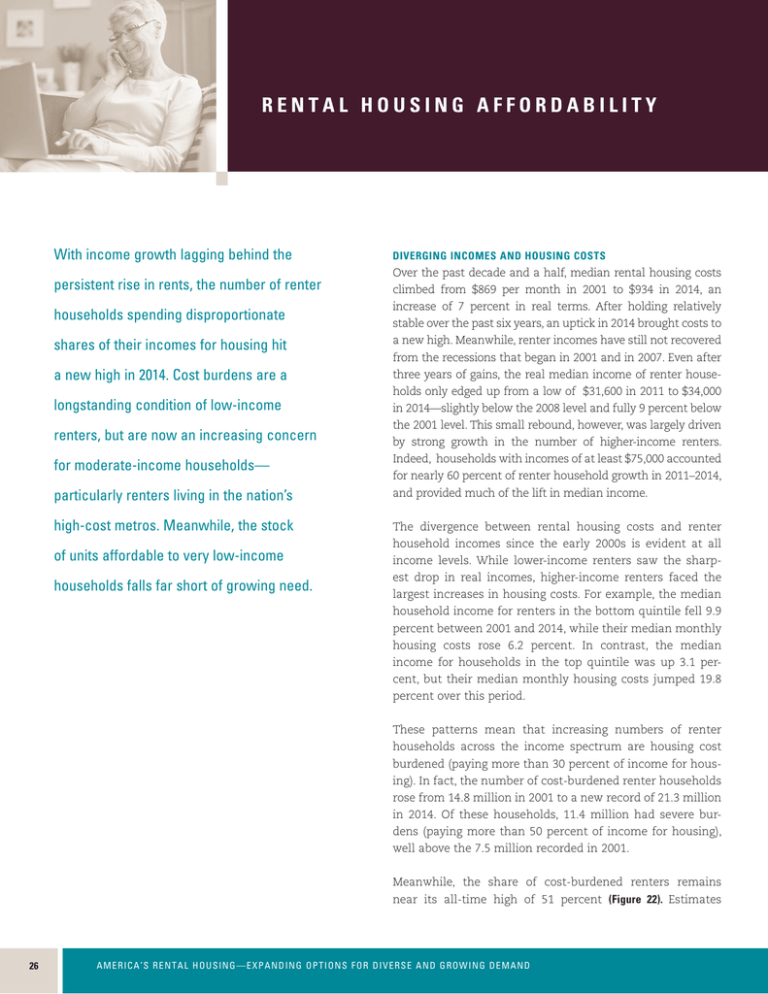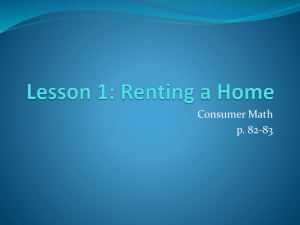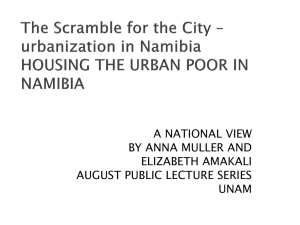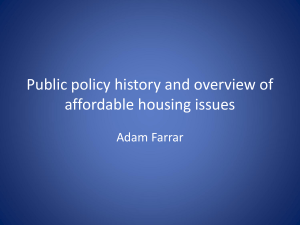R E N T A L H O... With income growth lagging behind the
advertisement

RENTAL HOUSING AFFORDABILITY With income growth lagging behind the persistent rise in rents, the number of renter households spending disproportionate shares of their incomes for housing hit a new high in 2014. Cost burdens are a longstanding condition of low-income renters, but are now an increasing concern for moderate-income households— particularly renters living in the nation’s high-cost metros. Meanwhile, the stock of units affordable to very low-income households falls far short of growing need. DIVERGING INCOMES AND HOUSING COSTS Over the past decade and a half, median rental housing costs climbed from $869 per month in 2001 to $934 in 2014, an increase of 7 percent in real terms. After holding relatively stable over the past six years, an uptick in 2014 brought costs to a new high. Meanwhile, renter incomes have still not recovered from the recessions that began in 2001 and in 2007. Even after three years of gains, the real median income of renter households only edged up from a low of $31,600 in 2011 to $34,000 in 2014—slightly below the 2008 level and fully 9 percent below the 2001 level. This small rebound, however, was largely driven by strong growth in the number of higher-income renters. Indeed, households with incomes of at least $75,000 accounted for nearly 60 percent of renter household growth in 2011–2014, and provided much of the lift in median income. The divergence between rental housing costs and renter household incomes since the early 2000s is evident at all income levels. While lower-income renters saw the sharpest drop in real incomes, higher-income renters faced the largest increases in housing costs. For example, the median household income for renters in the bottom quintile fell 9.9 percent between 2001 and 2014, while their median monthly housing costs rose 6.2 percent. In contrast, the median income for households in the top quintile was up 3.1 percent, but their median monthly housing costs jumped 19.8 percent over this period. These patterns mean that increasing numbers of renter households across the income spectrum are housing cost burdened (paying more than 30 percent of income for housing). In fact, the number of cost-burdened renter households rose from 14.8 million in 2001 to a new record of 21.3 million in 2014. Of these households, 11.4 million had severe burdens (paying more than 50 percent of income for housing), well above the 7.5 million recorded in 2001. Meanwhile, the share of cost-burdened renters remains near its all-time high of 51 percent (Figure 22). Estimates 26 AMERICA’S RENTAL HOUSING—EXPANDING OPTIONS FOR DIVERSE AND GROWING DEMAND from the American Community Survey indicate that the cost-burdened share of renters inched upward from 49.0 percent in 2013 to 49.3 percent in 2014—the first increase since 2011—with more than 26 percent of those households having severe burdens. By comparison, the share of renters with cost burdens in 2001 was 41 percent and the share with severe burdens was 20 percent. THE PERSISTENT SPREAD OF COST BURDENS Renters at the lower end of the income ladder are disproportionately likely to struggle with high housing costs. In 2014, just under 84 percent of households with incomes below $15,000 were cost burdened, including 72 percent of renters that paid more than half their incomes for housing. The shares of households facing cost burdens declined steadily with income, dropping from 77 percent of households earning $15,000–29,999 to just 5 percent of households with incomes of $75,000 and over. Even so, the sharpest growth in cost-burdened shares has been among middle-income households (Figure 23). The share of burdened households with incomes in the $30,000–44,999 range increased from 37 percent in 2001 to 48 percent in 2014, while that of households with incomes of $45,000–74,999 nearly doubled from 12 percent to 21 percent. Regardless of income level, though, the shares of cost- FIGURE 22 burdened households reached new peaks in 2014 among all but the highest-income renters. Given their lower median incomes, Hispanic and black renters, younger and older households, and single-earner households are especially likely to be housing cost burdened. While burden rates have risen across all racial and ethnic groups since 2001, they remain persistently high for Hispanic and black renter households at 56–57 percent. By comparison, 48 percent of Asian and other minority renters were cost burdened in 2014, along with 44 percent of white renters. Similarly, the incidence of cost burdens has risen across all age groups, but burdens are most prevalent among the youngest (under age 25) and oldest (aged 65 and over) renter households. In 2001, about half of all renters in both of these age groups were cost burdened, compared with 36 percent of renters aged 25–44 and 38 percent of those aged 45–64. By 2014, the share among renters aged 65 and over stood at 55 percent, while the share among renters under age 25 was at 62 percent. Although the share of cost-burdened renters in their prime working years (25–64) is markedly lower than for other age groups, the increase in share from 27 percent in 2001 to 36 percent in 2014 is troubling. Single-parent families and married couples with children together account for nearly one third of cost-burdened renter households (Figure 24). Single-parent families are particularly likely to have cost burdens, with nearly two-thirds paying more than 30 percent of their incomes for housing in 2014. The Share of Renter Households Facing Cost Burdens Remains High as Income Growth Lags Indexed Housing Costs and Incomes Cost-Burdened Share (Percent) 115 52 110 50 105 48 100 46 95 44 90 42 85 40 38 80 2001 2002 2003 2004 2005 2006 2007 2008 2009 2010 2011 2012 2013 2014 ■ Median Renter Income ■ Median Housing Costs ■ Housing Cost Burden Notes: Median housing costs and household incomes are adjusted to 2014 dollars using the CPI-U for All Items. Housing costs include cash rent and utilities. Cost-burdened households pay more than 30% of income for housing. Households with zero or negative income are assumed to have severe burdens, while households paying no cash rent are assumed to be without burdens. Source: JCHS tabulations of US Census Bureau, American Community Surveys. GEOGRAPHIC DISTRIBUTION OF COST BURDENS Affordability pressures affect renters in every state in the country, with shares of cost-burdened households ranging from over a third to well over half. The fact that at least 37 percent of renter households in every state spend more than 30 percent of their incomes on housing underscores the severity of the challenge nationwide. By 2014, only seven states had cost-burdened shares that were below the 2001 national average of 41 percent. Predictably, states with the worst burden rates contain highcost housing markets. The three states with the largest costburdened shares (54 percent or more) are Florida, California, and Hawaii, each of which includes metros where median rental housing costs are 1.2–2.0 times the national average. Renters in these states are also more likely to be severely burdened, with about three in ten spending more than half of their incomes on housing. JOINT CENTER FOR HOUSING STUDIES OF HARVARD UNIVERSITY 27 21 FIGURE 23 Cost Burdens Are a Fact of Life for Lowest-Income Renters, But Are Becoming More Common Among Middle-Income Households as Well Share of Renter Households with Cost Burdens (Percent) 90 80 70 60 50 40 30 20 10 0 2001 2006 2011 Under $15,000 2014 2001 2006 2011 $15,000–29,999 2014 2001 2006 2011 2014 2001 $30,000–44,999 2006 2011 2014 $45,000–74,999 2001 2006 2011 2014 $75,000 and Over Household Income ■ Severely Burdened ■ Moderately Burdened Notes: Household incomes are adjusted to 2014 dollars using the CPI-U for All Items. Moderately (severely) cost-burdened households pay more than 30% and up to 50% (more than 50%) of income for housing. Households with zero or negative income are assumed to have severe burdens, while households paying no cash rent are assumed to be without burdens. Source: JCHS tabulations of US Census Bureau, American Community Surveys. States where housing costs are moderate but median incomes are low also have large shares of severely burdened renters. In eight states—Alabama, Louisiana, Michigan, Mississippi, Maine, New Mexico, Ohio, and Tennessee—median housing costs fall into the bottom half of all states while median incomes rank in the bottom ten. As a result, more than a quarter of renter households in these states pay more than 50 percent of their incomes for housing. 28 metros of the South (such as McAllen, Memphis, and New Orleans), as well as in Northern and Rust Belt metros (such as Detroit, Grand Rapids, New Haven, and Philadelphia). Metro areas with the lowest shares of cost-burdened renters are generally located in Midwestern and Plains states. Included on this list are Des Moines, Kansas City, Tulsa, and Wichita, where about two in five renters spend more than 30 percent of income on housing. Renter incomes in these areas are close to or above the national median, while housing costs are below. In eight of the 10 largest metros with the lowest burden rates, real renter income growth in 2014 was also stronger than average, with six of these metros reporting income gains of more than 7 percent. In contrast, states with low housing costs and small renter populations tend to have smaller shares of cost-burdened renters. In the 14 states with the lowest shares, between 37 percent and 45 percent of renter households had cost burdens in 2014. In all 14, housing costs were well below the national median and the number of renter households was about 300,000 on average. With the exception of Vermont, these states are all located in the Plains or the South. SUPPLY SHORTFALLS At the metropolitan area level, eight of the 10 largest metros with the highest shares of cost-burdened renters are in Florida and California. Miami has the largest share of cost-burdened renters of any major metro in the country, at nearly 62 percent, as well as the largest share of severely burdened renters, at just over 35 percent. Beyond the highcost metro areas in Florida and in California, large shares of renters are severely cost burdened in several lower-income As demand for rental housing continues to escalate, growth of the affordable supply—especially for lowest-income renters— has failed to keep pace. As of 2013, 18.5 million renter households had very low incomes (up to 50 percent of area median). According to HUD’s most recent Worst Case Housing Needs Report, there were 18 million units that these renters could afford at the 30-percent-of-income standard, or about 97 units for every 100 households. However, many of these units were occupied by higher-income renters and/or had severe physical AMERICA’S RENTAL HOUSING—EXPANDING OPTIONS FOR DIVERSE AND GROWING DEMAND options are even more limited. In 2013, there were just 7.2 million units affordable to these renters, or 65 for every 100 households. Excluding inadequate and unavailable units, however, leaves only 34 affordable rentals for every 100 of these renters. FIGURE 24 About a Third of Cost-Burdened Renters Are Families with Children Share of Renter Households with Cost Burdens Single Parent 21% Single Person A recent analysis by the Urban Institute confirms the nationwide shortage of affordable housing for extremely low-income households. No county with a population of at least 20,000 provided more than 76 affordable, adequate, and available units for every 100 of these households. Instead, the average county with 500,000 or more people provided 25 affordable, adequate, and available units for every 100 extremely low-income renters. Even among smaller counties with populations between 20,000 and 100,000, the average county provided only 38 affordable, adequate, and available rental units for every 100 extremely low-income renter households in 2013 (Figure 25). Married with Children 41% 12% Married without Children 9% Other Non-Family 8% Other Family 9% Notes: Cost-burdened households pay more than 30% of income for housing. Households with zero or negative income are assumed to have severe burdens, while households paying no cash rent are assumed to be without burdens. Source: JCHS tabulations of US Census Bureau, 2014 American Community Survey. Federal assistance programs play a vital role in housing extremely low-income renters, and the supply of units for these households would be even more limited without the assisted stock. Indeed, on average in the nation’s largest counties, only four unassisted units are affordable, adequate, and available for every 100 extremely low-income households. FIGURE 25 Lowest-Income Renters Far Outnumber the Affordable, Adequate, and Available Rental Supply Average Number of Units per 100 Extremely Low-Income Renter Households 40 35 30 IMPACTS OF ENERGY AND TRANSPORTATION COSTS 25 Utility costs can add significantly to housing costs. According to the 2014 American Community Survey, the median renter paying utilities separately from rent spent $130 per month, with utilities accounting for 4 percent of income and 14 percent of housing costs. Given that the need for heating, cooling, lights, appliances, and other energy uses varies little across households, renters with incomes under $15,000 spent $120 per month on utility costs last year while those earning $15,000–29,999 spent $130. By comparison, higher-income households earning $75,000 and over spent about $150. 20 15 10 5 0 20,000– 99,999 100,000– 249,999 250,000– 499,999 500,000– 1,499,999 1,500,000 and Over County Population ■ Federally Assisted Units ■ Units without Federal Assistance Notes: Affordable is defined as costing no more than 30% of income for households with extremely low incomes (up to 30% of area median). Adequate units have complete bathrooms, running water, and electricity, and no indicators of major disrepair. Available units are not occupied by higher income renter households. Source: JCHS tabulations of Urban Institute, Mapping America’s Rental Housing Crisis 2011–13. deficiencies. When these unavailable and inadequate units are excluded, the affordable supply stood at just 58 units for every 100 very low-income renter households. For the 11.1 million renters with extremely low incomes (up to 30 percent of area median), the affordable housing As a share of income, utility payments are much more onerous for lower-income renters. At the median, utility costs eat up 17 percent of the incomes of renter households earning under $15,000 and 7 percent of the incomes of those earning $15,000–29,999. For renters earning $75,000 and over, however, utility costs represent just 2 percent of income. Although not usually included in measures of housing cost burdens, transportation costs are another major draw on household budgets. The Location Affordability Index—a tool developed by HUD, the Department of Transportation, and JOINT CENTER FOR HOUSING STUDIES OF HARVARD UNIVERSITY 29 21 the Environmental Protection Agency—offers insights into the combined burden of housing and transportation costs for different types of households living in different-sized metros. On average, a renter family of four with two commuters earning the median income for the region and living in a large metro area (population of 5 million or more) spends about 26 percent of income on housing costs and 17 percent on transportation costs. Similar families living in a mid-sized metro (population between 250,000 and 1 million) spend 24 percent of income on housing costs and 23 percent on transportation. And in the country’s smallest metro and micro areas (with populations under 100,000), these families spend 23 percent of income on housing and more than 28 percent on transportation. These results highlight how much transportation costs can add significantly to the affordability pressures facing renter households throughout the country. TRADEOFFS FOR COST-BURDENED RENTERS The difficult tradeoffs that many lower-income renter households have to make between housing affordability and location are evident in their spending choices. The 2014 Consumer Expenditure Survey indicates that severely costburdened renters in the bottom expenditure quartile (a proxy for low income) spent 60 percent less on transportation than otherwise similar households living in affordable rentals (Figure 26). This tradeoff between spending on housing and transportation may reflect in part the choice that some low-income renters make to live in units that are expensive but well located, rather than in units that are affordable but distant from work and other resources. Other spending cutbacks by severely cost-burdened renters are a measure of the constrained budgets they work within. After paying more than half their incomes for housing, severely burdened renters in the bottom expenditure quartile had on average just over $500 left per month to cover all other expenses. To stay within their means, these households spent on average 55 percent less on healthcare and 38 percent less on food than comparable households living in affordable housing. Working-age renters in the bottom expenditure quartile also put 42 percent less into retirement and pension savings than those in affordable housing. Such modest expenditures on basic needs and reduced savings for retirement have far-reaching implications for household members. Cutting back on food expenditures, in particular, may jeopardize the immediate health and wellbeing of cost-burdened renters. And over time, the inability to save sufficiently for retirement puts households’ financial stability in older age at risk. FIGURE 26 Paying an Outsized Share of Income for Housing Crowds Out Spending on Other Vital Needs THE OUTLOOK While the future trajectories of incomes and rents are difficult to project, demographic trends alone make further increases in the ranks of severely cost-burdened renters probable. In the decade ahead, the fastest-growing groups will be senior households and minority households—both of which have relatively low incomes and relatively high costburden shares. Monthly Spending by Renters in the Bottom Expenditure Quartile (Dollars) 400 350 300 250 200 150 100 50 0 Food Transportation Healthcare Retirement ■ Not Burdened ■ Severely Burdened Notes: Severely cost-burdened households pay more than 50% of income for housing. Households with zero or negative income are assumed to be severely burdened, while households paying no cash rent are assumed to be without burdens. Quartiles are equal fourths of all households ranked by total spending. Retirement expenditures are for renters under age 65 only. Source: JCHS tabulations of US Bureau of Labor Statistics, 2014 Consumer Expenditure Survey. 30 Results of a 2015 analysis by the Joint Center and Enterprise Community Partners indicate that the number of severely cost-burdened renters is likely to increase in most scenarios. Even under the most optimistic conditions (assuming household income gains exceed housing cost increases by one percentage point annually), the reduction in the number of severely cost-burdened renters would be less than 200,000 over the next decade. In the more likely case that renter incomes and housing costs both rise in line with inflation, the number of cost-burdened renter households would climb by 1.3 million to 13.1 million in 2025. AMERICA’S RENTAL HOUSING—EXPANDING OPTIONS FOR DIVERSE AND GROWING DEMAND






